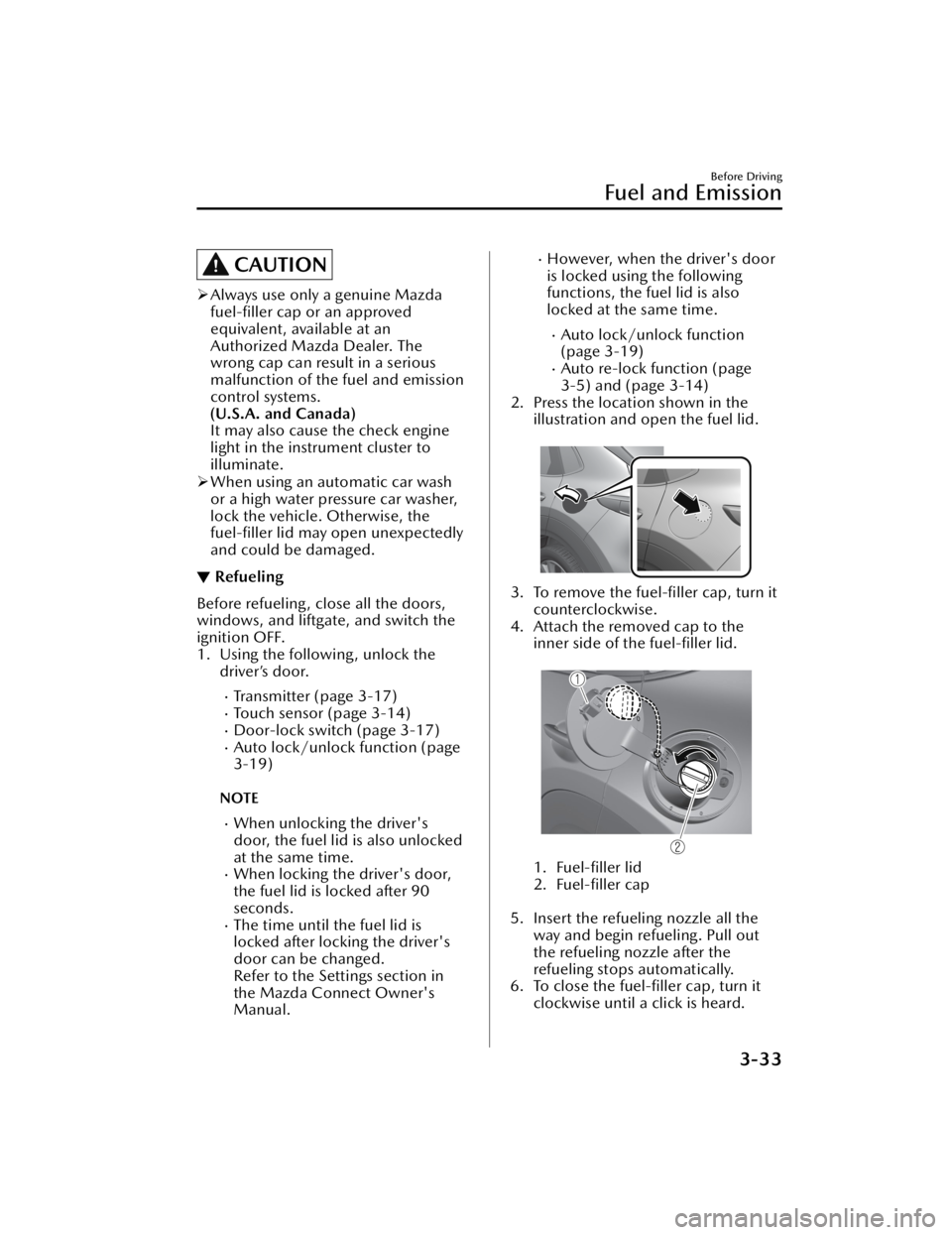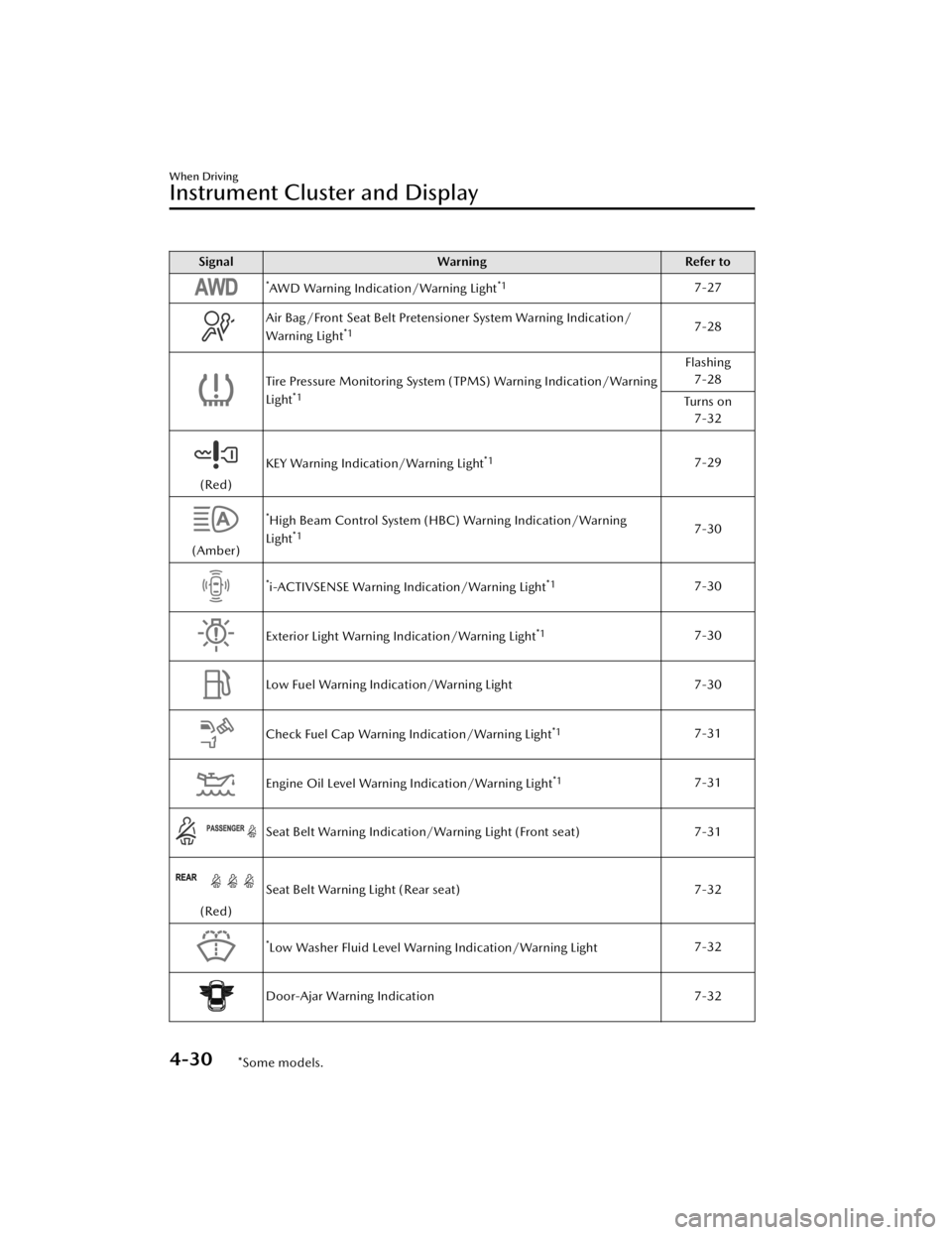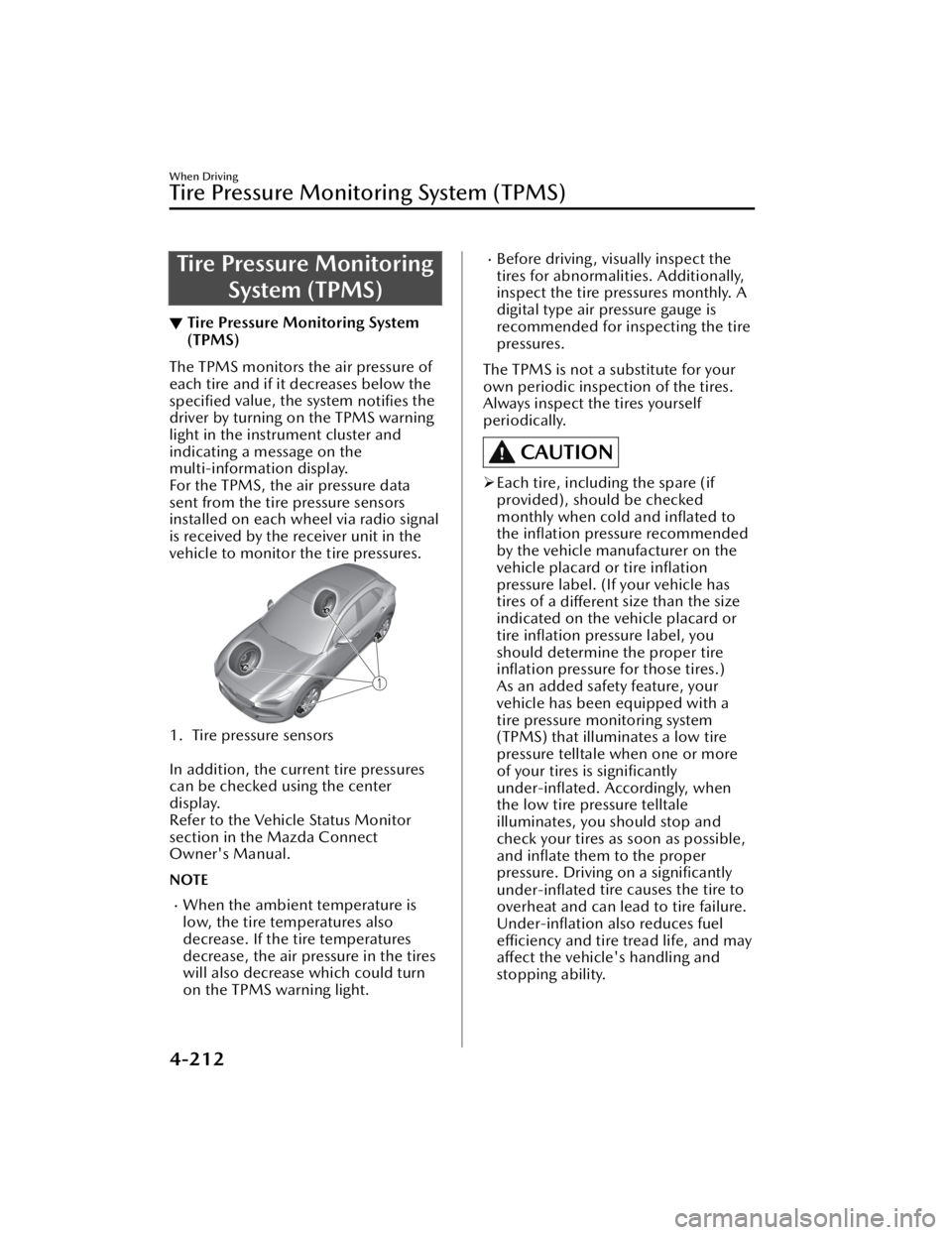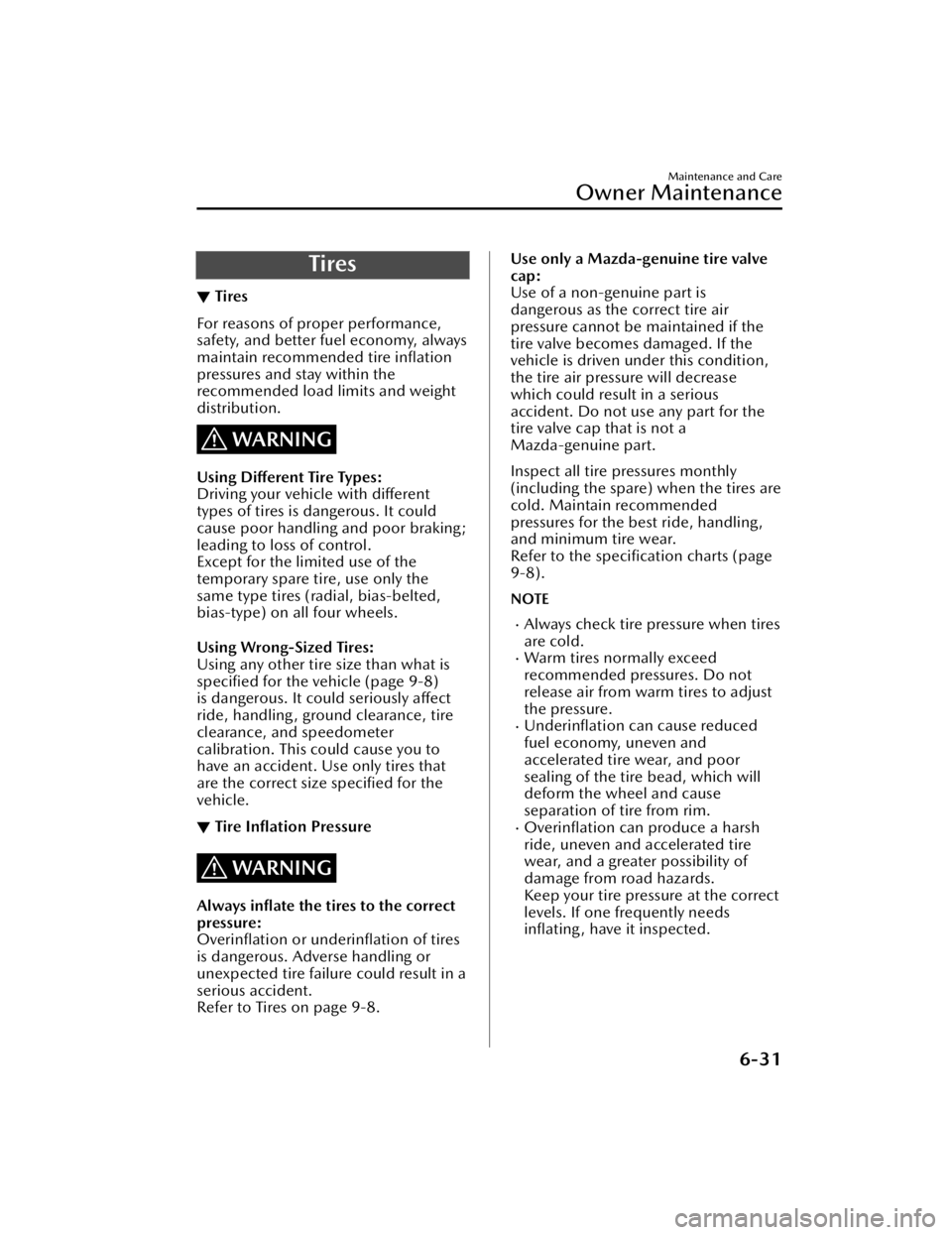fuel pressure MAZDA CX3 2023 Owners Manual
[x] Cancel search | Manufacturer: MAZDA, Model Year: 2023, Model line: CX3, Model: MAZDA CX3 2023Pages: 595, PDF Size: 32.7 MB
Page 121 of 595

Open the windows or adjust the
heating or cooling system to draw
fresh air when idling the engine:
Exhaust gas is dangerous. When the
vehicle is stopped with the windows
closed and the engine running for a
long time even in an open area,
exhaust gas, which contains poisonous
carbon monoxide, could enter the
cabin. Loss of consciousness or even
death could occur.
Clear snow from underneath and
around your vehicle, particularly the
tail pipe, before starting the engine:
Running the engine when a vehicle is
stopped in deep snow is dangerous.
The exhaust pipe could be blocked by
the snow, allowing exhaust gas to
enter the cabin. Because exhaust gas
contains poisonous carbon monoxide,
it could cause loss of consciousness or
even death to occupants in the cabin.Fuel-Filler Lid and Cap
▼Fuel-Filler Lid and Cap
WARNING
When removing the fuel-filler cap,
loosen the cap slightly and wait for
any hissing to stop, then remove it:
Fuel spray is dangerous. Fuel can burn
skin and eyes and cause illness if
ingested. Fuel spray is released when
there is pressure in the fuel tank and
the fuel-filler cap is removed too
quickly.
Before refueling, stop the engine, and
always keep sparks and flames away
from the filler neck:
Fuel vapor is dangerous. It could be
ignited by sparks or flames causing
serious burns and injuries.
Additionally, use of the incorrect
fuel-filler cap or not using a fuel-filler
cap may result in a fuel leak, which
could result in serious burns or death
in an accident.
Do not continue refueling after the
fuel pump nozzle shuts
off
automatically:
Continuing to add fuel after the fuel
pump nozzle has shut off automatically
is dangerous because overfilling the
fuel tank may cause fuel overflow or
leakage. Fuel overflow and leakage
could damage the vehicle and if the
fuel ignites it could cause a fire and
explosion resulting in serious injury or
death.
Before Driving
Fuel and Emission
3-32
CX-30_8KN2-EA-21L_Edition1_new 2021-9-15 19:39:56
Page 122 of 595

CAUTION
Always use only a genuine Mazda
fuel-filler cap or an approved
equivalent, available at an
Authorized Mazda Dealer. The
wrong cap can result in a serious
malfunction of the fuel and emission
control systems.
(U.S.A. and Canada)
It may also cause the check engine
light in the instrument cluster to
illuminate.
When using an automatic car wash
or a high water pressure car washer,
lock the vehicle. Otherwise, the
fuel-filler lid may open unexpectedly
and could be damaged.
▼ Refueling
Before refueling, close all the doors,
windows, and liftgate, and switch the
ignition OFF.
1. Using the following, unlock the
driver’s door.
Transmitter (page 3-17)Touch sensor (page 3-14)Door-lock switch (page 3-17)Auto lock/unlock function (page
3-19)
NOTE
When unlocking the driver's
door, the fuel lid is also unlocked
at the same time.
When locking the driver's door,
the fuel lid is locked after 90
seconds.
The time until the fuel lid is
locked after locking the driver's
door can be changed.
Refer to the Settings section in
the Mazda Connect Owner's
Manual.
However, when the driver's door
is locked using the following
functions, the fuel lid is also
locked at the same time.
Auto lock/unlock function
(page 3-19)
Auto re-lock function (page
3-5) and (page 3-14)
2. Press the location shown in the illustration and open the fuel lid.
3. To remove the fuel-filler cap, turn itcounterclockwise.
4. Attach the removed cap to the inner side of the fuel-filler lid.
1. Fuel-filler lid
2. Fuel-filler cap
5. Insert the refueling nozzle all the way and begin refueling. Pull out
the refueling nozzle after the
refueling stops automatically.
6. To close the fuel-filler cap, turn it clockwise until a click is heard.
Before Driving
Fuel and Emission
3-33
CX-30_8KN2-EA-21L_Edition1_new 2021-9-15 19:39:56
Page 177 of 595

SignalWarning Refer to
*AWD Warning Indication/Warning Light*17-27
Air Bag/Front Seat Belt Pretensioner System Warning Indication/
Warning Light*17-28
Tire Pressure Monitoring System (TPMS) Warning Indication/Warning
Light*1
Flashing
7-28
Tu r n s o n 7-32
(Red) KEY Warning Indication/Warning Light
*17-29
(Amber)
*High Beam Control System (HBC) Warning Indication/Warning
Light*17-30
*i-ACTIVSENSE Warning Indication/Warning Light*17-30
Exterior Light Warning Indication/Warning Light*17-30
Low Fuel Warning Indication/Warning Light 7-30
Check Fuel Cap Warning Indication/Warning Light*17-31
Engine Oil Level Warning Indication/Warning Light*17-31
Seat Belt Warning Indication/Warning Light (Front seat) 7-31
(Red)Seat Belt Warning Light (Rear seat)
7-32
*Low Washer Fluid Level Warning Indication/Warning Light7-32
Door-Ajar Warning Indication
7-32
When Driving
Instrument Cluster and Display
4-30*Some models.
CX-30_8KN2-EA-21L_Edition1_new 2021-9-15 19:39:56
Page 359 of 595

Tire Pressure MonitoringSystem (TPMS)
▼Tire Pressure Monitoring System
(TPMS)
The TPMS monitors the air pressure of
each tire and if it decreases below the
specified
value, the system
notifies the
driver by turning on the TPMS warning
light in the instrument cluster and
indicating a message on the
multi-information display.
For the TPMS, the air pressure data
sent from the tire pressure sensors
installed on each wheel via radio signal
is received by the receiver unit in the
vehicle to monitor the tire pressures.
1. Tire pressure sensors
In addition, the current tire pressures
can be checked using the center
display.
Refer to the Vehicle Status Monitor
section in the Mazda Connect
Owner's Manual.
NOTE
When the ambient temperature is
low, the tire temperatures also
decrease. If the tire temperatures
decrease, the air pressure in the tires
will also decrease which could turn
on the TPMS warning light.
Before driving, visually inspect the
tires for abnormalities. Additionally,
inspect the tire pressures monthly. A
digital type air pressure gauge is
recommended for inspecting the tire
pressures.
The TPMS is not a substitute for your
own periodic inspection of the tires.
Always inspect the tires yourself
periodically.
CAUTION
Each tire, including the spare (if
provided), should be checked
monthly when cold and
inflated to
the inflation pressure recommended
by the vehicle manufacturer on the
vehicle placard or tire inflation
pressure label. (If your vehicle has
tires of a different size than the size
indicated on the vehicle placard or
tire inflation pressure label, you
should determine the proper tire inflation pressure for those tires.)
As an added safety feature, your
vehicle has been equipped with a
tire pressure monitoring system
(TPMS) that illuminates a low tire
pressure telltale when one or more
of your tires is significantly
under-inflated. Accordingly, when
the low tire pressure telltale
illuminates, you should stop and
check your tires as soon as possible,
and inflate them to the proper
pressure. Driving on a significantly
under-inflated tire causes the tire to
overheat and can lead to tire failure.
Under-inflation also reduces fuel
efficiency and tire tread life, and may
affect the vehicle's handling and
stopping ability.
When Driving
Tire Pressure Monitoring System (TPMS)
4-212
CX-30_8KN2-EA-21L_Edition1_new 2021-9-15 19:39:56
Page 440 of 595

Canada residents
Maintenance IntervalNumber of months or kilometers
(miles), whichever comes first.
Months 6 1218243036424854606672
×1000 km 8 1624324048566472808896
×1000 miles 5 10 15 20 25 30 35 40 45 50 55 60
Engine oil & filter
*1*2Replace when the wrench indicator light is ON.
(Upper limit interval is 16,000 km (10,000 miles) or 12
months.)
Spark plugs SKYACTIV-G
2.5T
Replace every 64,000 km (40,000 miles).
Except SKY-
ACTIV-G
2.5T Replace every 120,000 km (75,000 miles).
Air filter Replace every 56,000 km (35,000 miles) or 36 months.
Drive belts
*3II
Engine coolant level IIIIIIIIIIII
Engine coolant
*4Replace at first 192,000 km (120,000 miles) or 120
months; after that, every 96,000 km (60,000 miles) or
60 months.
Fuel lines & hoses
*5III
Hoses and tubes for emission
*5I
Brake lines, hoses and connections III
Vacuum brake booster and hose IIIIII
Disc brakes IIIIII
Tire rotation Rotate every 8,000 km (5,000 miles).
Tire inflation pressure and tire wear
*6IIIIIIIIIIII
Steering operation and linkages III
Front and rear suspension, ball joints and
wheel bearing axial play III
Body condition inspection for rust, corro-
sion and perforation IIIIII
Driveshaft dust boot III
Bolts and nuts on chassis and body TTT
Exhaust system and heat shields I
C ab in a ir fi lt e r RRR
Chart symbols:
I: Inspect: Inspect and clean, repair, adjust, fill up, or replace if necessary.
Maintenance and Care
Scheduled Maintenance
6-7
CX-30_8KN2-EA-21L_Edition1_new 2021-9-15 19:39:56
Page 442 of 595

2. Driving under dusty conditions.
3. Driving for long periods in cold temperatures or driving regularly for short distan-
ces only.
4. Driving under extremely high temperature conditions.
5. Driving continuously in mountainous regions.
If you are following the Severe Driving Scheduled Maintenance (5,000 km or 3
months oil replacement interval), set the vehicle status monitor manually.
Refer to the Information section in th e Mazda Connect Owner's Manual. Please
contact an Authorized Mazda Dealer if necessary.
Mexico Residents (Normal Driv ing Scheduled Maintenance):
Maintenance Item Number of times, maintenance was performed.
12345678
Engine oil & filter
*1RRRRRRRR
Spark plugs SKYACTIV-G
2.5T
IIIIIIII
Replace every 64,000 km
Except SKY-
ACTIV-G
2.5T IIIIIIII
Replace every 120,000 km.
Air filter RR RR
Drive belts IIIIIIII
Engine coolant level IIIIIIII
Engine coolant
*2Replace at first 192,000 km or 120 months; after that, every 96,000 km or 60 months.
Fuel lines & hoses
*3II
Hoses and tubes for emission
*3II
Fuel filter Replace every 60,000 km.
Brake lines, hoses and connections II II
Vacuum brake booster and
hose With vacuum
booster
IIII
Brake and clutch fluid level III III
Brake fluid RR
Disc brakes IIIIIIII
Tire rotation Rotate every 10,000 km.
Tire inflation pressure and tire wear
*4IIIIIIII
Steering operation and linkages IIIIIIII
Front and rear suspension, ball joints and
wheel bearing axial play IIII
Maintenance and Care
Scheduled Maintenance
6-9
CX-30_8KN2-EA-21L_Edition1_new
2021-9-15 19:39:56
Page 444 of 595

Owner MaintenancePrecautions
▼Owner Maintenance Precautions
The owner or a qualified service
technician should make these vehicle
inspections at the indicated intervals to
ensure safe and dependable
operation.
Bring any problem to the attention of
an Authorized Mazda Dealer or
qualified service technician as soon as
possible.
When Refueling
Brake fluid level (page 6-20)Engine coolant level (page 6-18)Engine oil level (page 6-17)Washer fluid level (page 6-20)
At Least Monthly
Tire inflation pressures (page 6-31)
At Least Twice a Year (For Example,
Every Spring and Fall)
You can do the following scheduled
maintenance items if you have some
mechanical ability and a few basic
tools and if you closely follow the
directions in this manual.
Engine coolant (page 6-18)Engine oil (page 6-17)
Improper or incomplete service may
result in problems. This section gives
instructions only for items that are easy
to perform.
As explained in the Introduction (page
6-2), several procedures can be done
only by a qualified service technician
with special tools.
Improper owner maintenance during
the warranty period may affect
warranty coverage. Refer to
Introduction (page 6-2) for owner's
responsibility in protecting your
investment. For details, read the
separate Mazda Warranty statement
provided with the vehicle. If you are
unsure about any servicing or
maintenance procedure, have it done
by an Authorized Mazda Dealer.
There are strict environmental laws
regarding the disposal of waste oil and
fluids. Please dispose of your waste
properly and with due regard to the
environment.
We recommend that you entrust the oil
and fluid changes of your vehicle to an
Authorized Mazda Dealer.
WARNING
Do not perform maintenance work if
you lack sufficient knowledge and
experience or the proper tools and
equipment to do the work. Have
maintenance work done by a
qualified technician:
Performing maintenance work on a
vehicle is dangerous if not done
properly. You can be seriously injured
while performing some maintenance
procedures.
Maintenance and Care
Owner Maintenance
6-11
CX-30_8KN2-EA-21L_Edition1_new 2021-9-15 19:39:56
Page 464 of 595

Tires
▼Tires
For reasons of proper performance,
safety, and better fuel economy, always
maintain recommended tire
inflation
pressures and stay within the
recommended load limits and weight
distribution.
WARNING
Using Different Tire Types:
Driving your vehicle with different
types of tires is dangerous. It could
cause poor handling and poor braking;
leading to loss of control.
Except for the limited use of the
temporary spare tire, use only the
same type tires (radial, bias-belted,
bias-type) on all four wheels.
Using Wrong-Sized Tires:
Using any other tire size than what is
specified for the vehicle (page 9-8)
is dangerous. It could seriously affect
ride, handling, ground clearance, tire
clearance, and speedometer
calibration. This could cause you to
have an accident. Use only tires that
are the correct size specified for the
vehicle.
▼ Tire Inflation Pressure
WARNING
Always inflate the tires to the correct
pressure:
Overinflation or underinflation of tires
is dangerous. Adverse handling or
unexpected tire failure could result in a
serious accident.
Refer to Tires on page 9-8.
Use only a Mazda-genuine tire valve
cap:
Use of a non-genuine part is
dangerous as the correct tire air
pressure cannot be maintained if the
tire valve becomes damaged. If the
vehicle is driven under this condition,
the tire air pressure will decrease
which could result in a serious
accident. Do not use any part for the
tire valve cap that is not a
Mazda-genuine part.
Inspect all tire pressures monthly
(including the spare) when the tires are
cold. Maintain recommended
pressures for the best ride, handling ,
and minimum tire wear.
Refer to the specification charts (page
9-8).
NOTE
Always check tire pressure when tires
are cold.
Warm tires normally exceed
recommended pressures. Do not
release air from warm tires to adjust
the pressure.
Underinflation can cause reduced
fuel economy, uneven and
accelerated tire wear, and poor
sealing of the tire bead, which will
deform the wheel and cause
separation of tire from rim.
Overinflation can produce a harsh
ride, uneven and accelerated tire
wear, and a greater possibility of
damage from road hazards.
Keep your tire pressure at the correct
levels. If one frequently needs inflating, have it inspected.
Maintenance and Care
Owner Maintenance
6-31
CX-30_8KN2-EA-21L_Edition1_new 2021-9-15 19:39:56
Page 478 of 595

When the ignition is switched ON
and the wiper lever is in the AUTO
position, do not touch the
windshield or the windshield wipers
Otherwise, the windshield wipers
will operate automatically which
could catch your fingers or damage
the windshield wipers.
When removing ice or snow, or
cleaning the windshield, always
make sure the wiper lever is in the
OFF position.
Do not spray water in the engine
compartment. Otherwise, it could
result in engine-starting problems or
damage to electrical parts.
When washing and waxing the
vehicle, be careful not to apply
excessive force to any single area of
the vehicle roof or the antenna.
Otherwise, you could dent the
vehicle or damage the antenna.
Make sure that the fuel-filler lid is
closed and lock the doors.
Otherwise, the
fuel-filler lid may be
forcefully opened by water pressure
causing damage to the vehicle or
fuel-filler lid.
To help protect the finish from rust and
deterioration, wash your Mazda
thoroughly and frequently, at least
once a month, with lukewarm or cold
water.
If the vehicle is washed improperly, the
paint surface could be scratched. Here
are some examples of how scratching
could occur.
Scratches occur on the paint surface
when:
The vehicle is washed without first
rinsing off dirt and other foreign
matter.
The vehicle is washed with a rough,
dry, or dirty cloth.
The vehicle is washed at a car wash
that uses brushes that are dirty or too stiff.
Cleansers or wax containing
abrasives are used.
NOTE
Mazda is not responsible for
scratches caused by automatic car
washes or improper washing.
Scratches are more noticeable on
vehicles with darker paint finishes.
To minimize scratches on the vehicle's
paint finish:
Rinse off any dirt or other foreign
matter using lukewarm or cold water
before washing.
Use plenty of lukewarm or cold
water and a soft cloth when washing
the vehicle. Do not use a nylon cloth.
Rub gently when washing or drying
the vehicle.
Take your vehicle only to a car wash
that keeps its brushes well
maintained.
Do not use abrasive cleansers or wax
that contain abrasives.
CAUTION
Do not use steel wool, abrasive
cleaners, or strong detergents
containing highly alkaline or caustic
agents on chrome-plated or
anodized aluminum parts. This may
damage the protective coating; also,
cleaners and detergents may discolor
or deteriorate the paint.
Pay special attention to removing salt,
dirt, mud, and other foreign material
from the underside of the fenders, and
make sure the drain holes in the lower
Maintenance and Care
Appearance Care
6-45
CX-30_8KN2-EA-21L_Edition1_new 2021-9-15 19:39:56
Page 562 of 595

Overloading makes a vehicle harder to
drive and control. It also increases the
distance required for stopping. In cases
of serious overloading , brakes can fail
completely, particularly on steep
grades. The load a tire will carry safely
is a combination of the size of the tire,
its load range, and corresponding
inflation pressure.
Never overload the vehicle and always
observe the vehicle's weight ratings
from the vehicle's Safety Certification
and Tire and Load Information labels.Base Curb Weight is the weight of the
vehicle including a full tank of fuel
and all standard equipment. It does
not include passengers, cargo, or
optional equipment.
Vehicle Curb Weight is the weight of
your new vehicle when you picked it
up from your dealer plus any
aftermarket equipment.
PAY LOA D
Pay l o a d is the combination weight of
cargo and passengers that the vehicle
is designed to carry. The maximum
payload for your vehicle can be found
on the Tire and Load Information label
on the driver's door frame or door
pillar. Look for “THE COMBINATION
WEIGHT OF OCCUPANTS AND
CARGO SHOULD NEVER EXCEED XXX
kg or XXX lbs” for your maximum
payload. The payload listed on the tire
label is the maximum payload for the
vehicle as built by the assembly plant.
If any aftermarket or dealer installed
equipment has been installed on the
vehicle, the weight of the equipment
must be subtracted from the payload
listed on the tire label in order to be
accurate.
Customer Information and Reporting Safety Defects
Tire Information (U.S.A.)
8-31
CX-30_8KN2-EA-21L_Edition1_new 2021-9-15 19:39:56